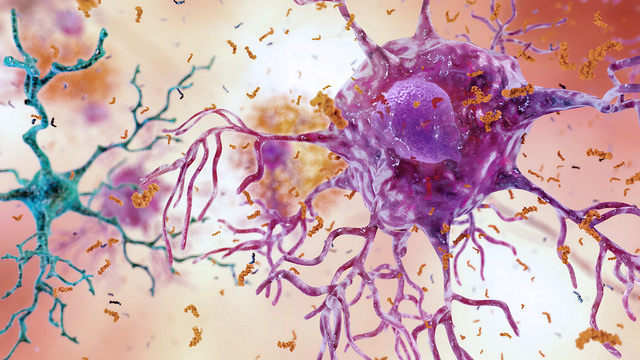
Apolipoproteins (Apos) are proteins that transport lipids by binding to them. They also can act as enzyme co-factors and cell-surface receptor ligands. Without proper function of apolipoproteins in the body, a variety of disorders would appear. For example, ApoE can influence your risk for late-onset type of Alzheimer’s disease (AD). There are three ApoE gene variants in humans: ApoE2, ApoE3, and ApoE4. Many researchers have wondered why ApoE4 increases the risk of AD. Although there have been numerous studies attempting to explain the underlying mechanism for this increased risk, the manner in which ApoE4 influences AD onset and progression has yet to be proven. Now, a team of researchers from the Max Delbrück Center for Molecular Medicine (MDC) in the Helmholtz Association may have found an explanation.
Their study, “Apolipoprotein E4 disrupts the neuroprotective action of sortilin in neuronal lipid metabolism and endocannabinoid signaling,” is published in Alzheimer’s & Dementia and led by Antonino Asaro, PhD, postdoctoral researcher at MDC.
“Apolipoprotein E (apoE) is a carrier for brain lipids and the most important genetic risk factor for Alzheimer’s disease (AD). ApoE binds the receptor sortilin, which mediates uptake of apoE‐bound cargo into neurons. The significance of this uptake route for brain lipid homeostasis and AD risk seen with apoE4, but not apoE3, remains unresolved,” the researchers wrote.

“We used a custom mouse model to simulate the human lipid metabolism,” explained Thomas Willnow, PhD, professor and group leader at MDC.
The researchers studied the lipid composition of the mice brains using mass spectrometry. They found that the lipid composition was healthy in the brain of mice with ApoE3 with sufficient amounts of unsaturated fatty acids and endocannabinoids. Compared to the brain cells of E3, the E4 mice did not receive enough lipids. The researchers saw that in the ApoE4 mice, the membrane vesicles that normally bring sortilin from the cell interior back to the cell surface had gotten stuck inside the neuron.
Sortilin binds the lipid-loaded ApoE3. After depositing the cargo inside the neurons, sortilin returns to the cell surface to bind new ApoE. This process repeats itself to supply neurons with sufficient amounts of essential fatty acids. But it comes to a halt whenever ApoE4 is involved.
If sortilin binds ApoE4 and transports it into the neuron’s interior, the receptor clumps up inside the cell, which makes it unable to return to the cell surface. Fewer and fewer fatty acids are taken up, and the cells become vulnerable and inflamed. As a result, they are susceptible to cell death as the aging process sets in, increasing the risk of developing AD.
“This finding may provide the basis for a new strategy to treat Alzheimer’s,” Willnow said. Understanding why ApoE4 increases Alzheimer’s disease may pave the way for effective ApoE4-directed AD treatment approaches.













